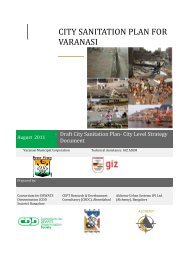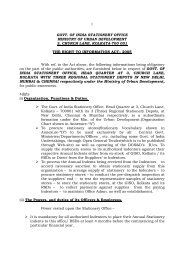CITY SANITATION PLAN - Ministry of Urban Development
CITY SANITATION PLAN - Ministry of Urban Development
CITY SANITATION PLAN - Ministry of Urban Development
You also want an ePaper? Increase the reach of your titles
YUMPU automatically turns print PDFs into web optimized ePapers that Google loves.
<strong>CITY</strong> <strong>SANITATION</strong> <strong>PLAN</strong> BAREILLY<br />
understanding the human behavior in terms <strong>of</strong> their usage <strong>of</strong> the available sanitation and sewerage<br />
facilities <strong>of</strong> different respondents. This project study also considers the situational analysis <strong>of</strong> available<br />
services provided and the usage patterns <strong>of</strong> these services by the population throughout the city. This<br />
research project study also into qualitative analysis to support the interpretations made which includes<br />
interviews, questionnaire surveys and analysis <strong>of</strong> primary and secondary data to estimate the current<br />
status <strong>of</strong> sanitation and sewerage and other key potential issues and also to evaluate the possible<br />
recommendations/ proposals to meet the goals <strong>of</strong> the project. Thus, positivism approach is most<br />
appropriate to the current study. In addition, the other possible paradigm is Critical Realm which also<br />
considers social factors involved in shaping the city and its infrastructure services and facilities. It was<br />
expected that population’s role in usage patterns <strong>of</strong> these available infrastructure facilities influence the<br />
healthy and livable conditions <strong>of</strong> the city. Since the research project study considers the population’s<br />
socio-economic and demographic details and their behavior that influences the living conditions in the<br />
city, the critical realism can also be considered as an apt approach. Further to epistemology<br />
considerations, ontology <strong>of</strong> the research considered the constructive nature. This is primarily depended<br />
upon the facts that the research being accomplished solely by population at the city level and also<br />
unavoidable personal bias in carrying out the research.<br />
RESEARCH STRATEGIES: The current research project is in assessment <strong>of</strong> key potential problems related<br />
to sanitary, sewerage and solid waste management and provides suitable strategy options to overcome<br />
them. Therefore, this involves robust and in-depth study for which Case Study Approach was used for<br />
analyzing the situation and gaps in sanitary conditions. As the case study approach <strong>of</strong> research is more<br />
precise to specific boundaries and make convenience in collection <strong>of</strong> data (Denscombe, 2007; Blaxter et<br />
al, 2006), it became the appropriate strategy for the current project study. Therefore, the case study<br />
population that was chosen for the current research study includes population at residential areas, slum<br />
areas, institutional areas, schools, hospitals, public areas, industries, market places, commercial areas<br />
and understanding the sanitary conditions at these places.<br />
RESEARCH METHODS: As this research study involves qualitative analysis that involves statistical<br />
methods to support the situational analysis and interpretations <strong>of</strong> the research team. And one <strong>of</strong> the<br />
best qualitative methods is a closed questionnaire interview which directly helps in collecting the<br />
required data and estimates the gaps and conditions – based on which the proposal could be given to<br />
ADMINISTRATIVE STAFF COLLEGE OF INDIA, HYDERABAD Page 19
















